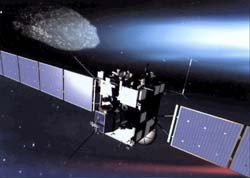Top class images help ESA’s Rosetta prepare to ride on a cosmic bullet

Rosetta’s goal is to unravel the origins of the Solar System
Chase a fast-moving comet, land on it and ’ride’ it while it speeds up towards the Sun: not the script of a science-fiction movie, but the very real task of ESA’s Rosetta spacecraft.
New observations with the European Southern Observatory’s (ESO) Very Large Telescope (VLT) provide vital information about Comet Wirtanen – Rosetta’s target – to help ESA reduce uncertainties in the mission, one of the most difficult ever to be performed.
Every 5.5 years Comet Wirtanen completes an orbit around the Sun. Wirtanen has been seen during almost all its apparitions ever since its discovery in 1948, but only recently have astronomers obtained detailed observations that have allowed them to estimate the comet’s size and behaviour. The most recent of these observations was performed in December 2001 with the Very Large Telescope (VLT), located at the Paranal Observatory (Chile). As a result of these observations ESA will be able to refine plans for its Rosetta mission.
Rosetta will be launched next year and it will reach Comet Wirtanen in 2011. By that time the comet will be as far from the Sun as Jupiter, charging headlong towards the inner Solar System at speeds of up to 135,000 km/h. To get there and to be able to match the comet’s orbit, Rosetta will need to be accelerated by several planetary swing-bys, after which the spacecraft – following a series of difficult manoeuvres – will get close to the comet, enter into orbit around it and release a lander from a height of about 1 km.
The VLT observations were planned specifically to investigate the activity of Wirtanen at the time of the landing manoeuvres. These observations have confirmed that – at the same distance from the Sun at which the landing will take place (450 million km) – the activity on Wirtanen is very low. This is very good news for the mission, because it means that there will not be so much dust ejected as to make the landing dramatically difficult.
Comets are basically small frozen bodies made of ice and dust. When they get close to the Sun the heat causes ices on the comet’s surface to “evaporate”, and gas and dust grains are ejected into the surrounding space forming the comet’s atmosphere (coma) and the tail. In addition to dropping a lander on the comet’s nucleus for detailed in-situ observations, Rosetta’s task is to investigate the evolution of the comet on its way to the Sun: in fact, Rosetta will keep orbiting around Wirtanen up to the end of the mission in July 2013, at which time the comet is at its closest approach to the Sun, at about 160 million km from it.
VLT observations have also provided Rosetta mission planners with an accurate measurement of their target’s size: Wirtanen is only 1.2 km in diameter, a true cosmic bullet.
“Rosetta is certainly a very challenging space mission. No one has ever tried to land on a comet before,” says Gerhard Schwehm, Rosetta’s Project Scientist. “We need to learn as much as possible about our target. The new data will allow us to improve our models and make decisions once we get there.”
Media Contact
More Information:
http://www.esa.intAll latest news from the category: Physics and Astronomy
This area deals with the fundamental laws and building blocks of nature and how they interact, the properties and the behavior of matter, and research into space and time and their structures.
innovations-report provides in-depth reports and articles on subjects such as astrophysics, laser technologies, nuclear, quantum, particle and solid-state physics, nanotechnologies, planetary research and findings (Mars, Venus) and developments related to the Hubble Telescope.
Newest articles

First-of-its-kind study uses remote sensing to monitor plastic debris in rivers and lakes
Remote sensing creates a cost-effective solution to monitoring plastic pollution. A first-of-its-kind study from researchers at the University of Minnesota Twin Cities shows how remote sensing can help monitor and…

Laser-based artificial neuron mimics nerve cell functions at lightning speed
With a processing speed a billion times faster than nature, chip-based laser neuron could help advance AI tasks such as pattern recognition and sequence prediction. Researchers have developed a laser-based…

Optimising the processing of plastic waste
Just one look in the yellow bin reveals a colourful jumble of different types of plastic. However, the purer and more uniform plastic waste is, the easier it is to…


